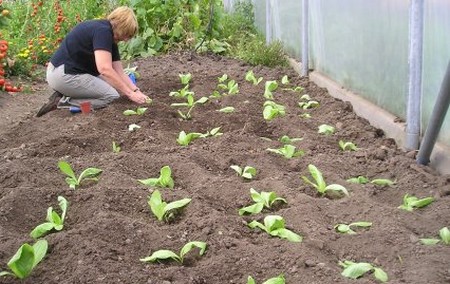These continental salad plants are a major ingredient in the bags of exotic salad mixtures available in supermarkets. They are fairly easy to grow and can be harvested late in the season. Both are very decorative in an ornamental border, with a choice of frilly and red types. They can be blanched to reduce the characteristic bitter taste, and certain types of chicory can be forced. Both crops are also useful additions to a mixed-leaf salad, and grown as cut-and-come-again crops.
Calendar
February- April
Sow chicory and endive little and often as a cut-and-come-again crop.
April-June
Sow frilly endives for a summer crop, either in pots for planting out later, or direct. Allow 20-30cm between plants.
July-August
Blanch frilly endives sown earlier once the hearts are full-sized (about the size of your fist) by covering them for a week or two with something heavy and round, such as a dinner plate, to exclude light.
Sow chicory and endive (especially broad-leaved varieties) for winter salads and for forcing. You can sow into a seed bed for transplanting later on. If you want only a few plants, sow a couple of seeds in a 7-cm pot. Keep well watered and pull out the weaker seedlings later if more than one germinates.
August-September
Plant the young plants outside. Allow roughly 25cm per plant if you want them to develop large heads, closer if you want a supply of loose leaves. Red and variegated varieties will start to develop their distinct coloring as the temperature begins to drop.
A late sowing of hardy endive is worth considering under cloches or in an unheated greenhouse during September.
Harvesting
Harvest roots for forcing as chicons in November. Pick leaves of hardy chicory and endive as required for winter salads.
How to grow chicons
These are the blanched young shoots of certain types of chicory. The taste is much milder than outdoor chicory.
Lift the roots in November. You want unforked roots with a diameter of 2.5-5cm across the top. Cut the foliage to within 2.5cm of the root and trim the root to 15-20cm. If there has not been a frost, lay them outdoors before storing. A frost will break their dormancy and make them easier to force later. Store horizontally in boxes of damp sand.
Take three or four roots at a time and plant them in 25-cm pots filled with multipurpose compost, so that the crowns are just visible. Cover them to exclude all light (you could use another pot with the drainage holes covered). Put them somewhere warm, with a temperature of at least 10-13’C. After three or four weeks, a chicon should grow from each root.
You can also force chicory outdoors by covering the trimmed roots with a low mound of soil 20cm high. Cover this with cloches or straw and wait until early spring, when the chicons should break through the soil surface.
